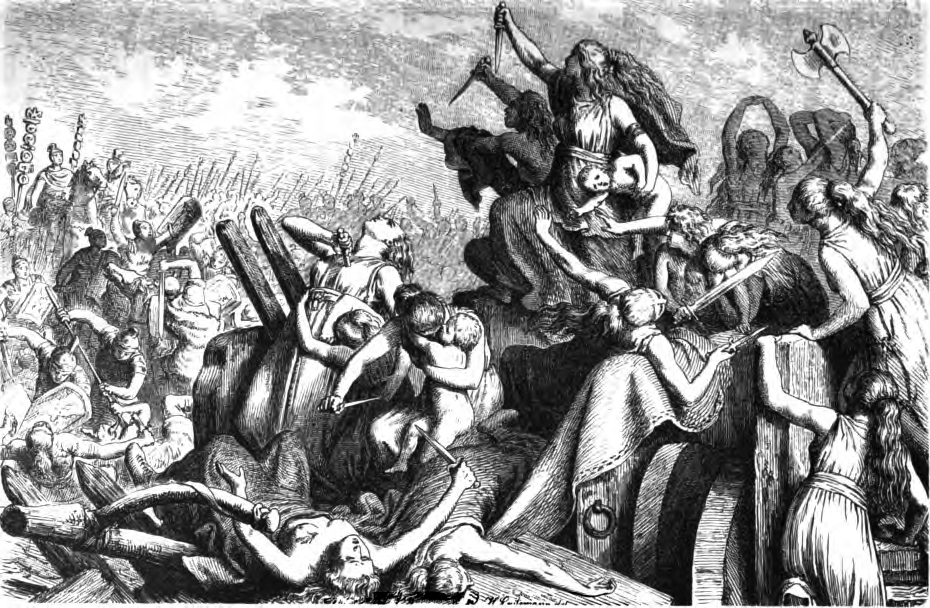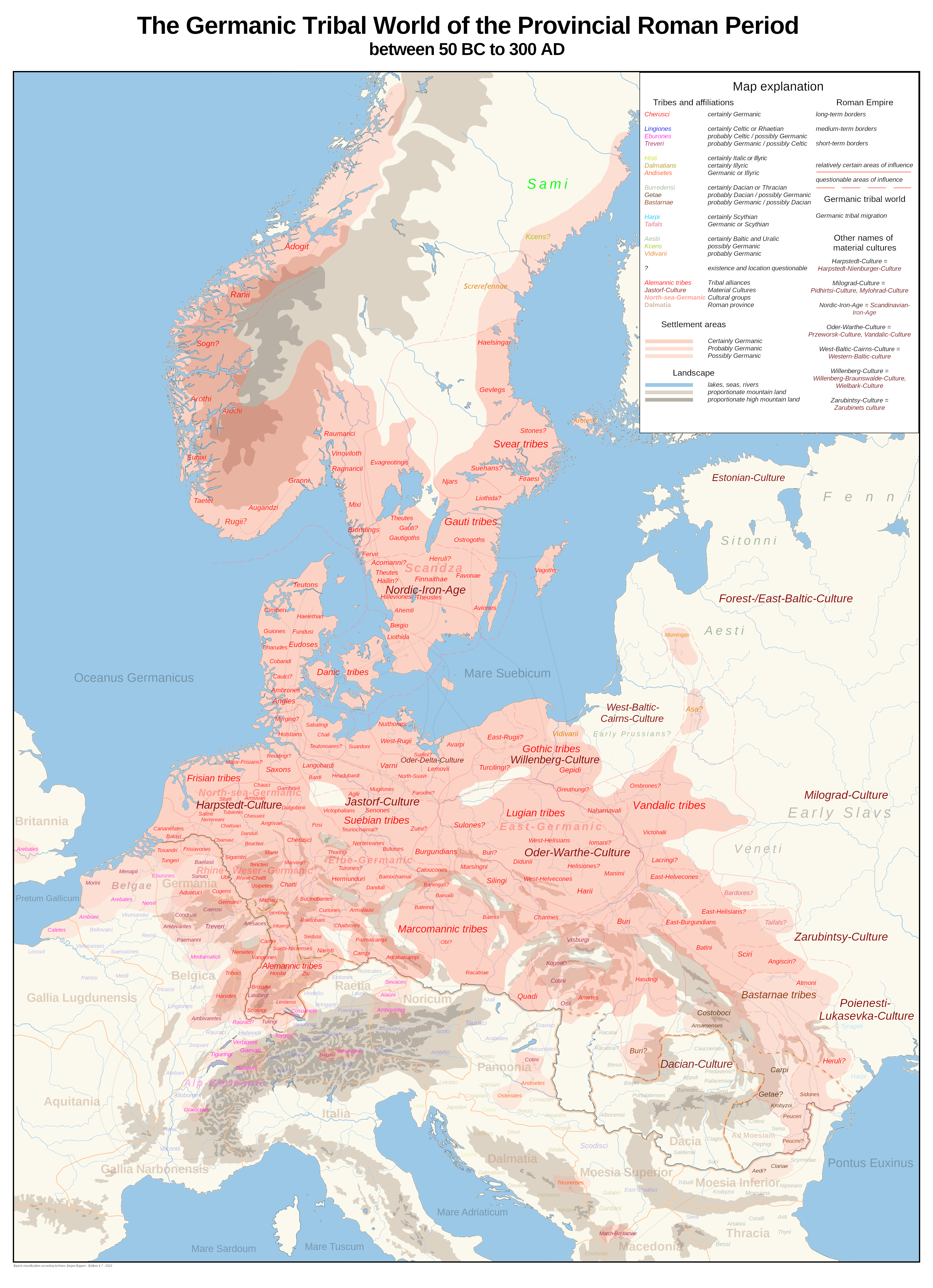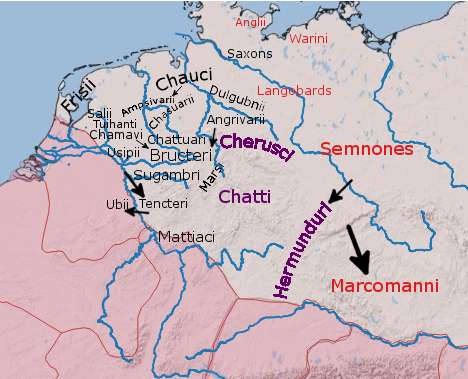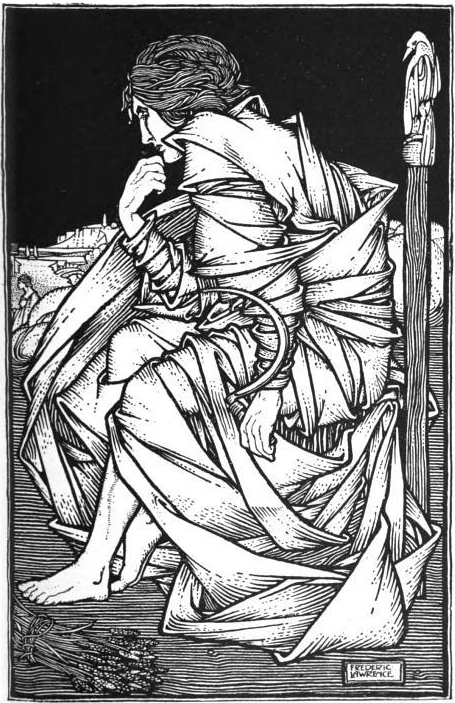|
Ingaevones
The Ingaevones () or Ingvaeones () were a Germanic peoples, Germanic cultural group living in the Northern Germania along the North Sea coast in the areas of Jutland, Holstein, and Lower Saxony in classical antiquity. Tribes in this area included the Angles (tribe), Angles, Chauci, Saxons, and Jutes. The name is transmitted in two different forms in ancient sources: Tacitus provides the form , while Pliny the Elder has . Most scholars derive the name from the god or hero attested under the name Yngvi in later Norse sources, and thus believe Pliny's form is the original one. Hence the postulated common group of closely related dialects of the "Ingvaeones" is called Ingvaeonic or North Sea Germanic. Tacitus' source categorized the ''Ingaevones near the ocean'' as one of the three tribal groups descended from the three sons of Mannus, son of Tuisto, progenitor of all the Germanic peoples, the other two being the ''Irminones'' and the ''Istaevones''. According to the speculations of ... [...More Info...] [...Related Items...] OR: [Wikipedia] [Google] [Baidu] |
Yngvi
Old Norse Yngvi , Old High German Ing/Ingwi and Old English Ing are names that relate to a Lists of deities, theonym which appears to have been the older List of names of Freyr, name for the god Freyr. Proto-Germanic language, Proto-Germanic Ingwaz was the legendary ancestor of the Ingaevones, or more accurately ''Ingvaeones'', and is also the reconstructed name of the Elder Futhark runes, rune ᛜ and Anglo-Saxon runes, Anglo-Saxon rune ᛝ, representing ''ŋ''. Etymology Old Norse ''Yngvi'' as well as Old High German ''Inguin'' and Old English ''Ingƿine'' are all derived from the Proto-Germanic language, Proto-Germanic *Ingwaz. Sound changes in late-Proto-Germanic transformed *Ingwaz into *Ingwi(z) in the nominative case and *''Ingwin'' in the accusative case. His epithet *Fraujaz appears in Old Norse compounds ''Ingvifreyr'' and ''Ingunarfreyr''. In Beowulf we see Hrothgar called (OE) ''fréa inguina'', which means 'Lord of the Inguins', i.e. lord of the Ingvaeones, the 'fri ... [...More Info...] [...Related Items...] OR: [Wikipedia] [Google] [Baidu] |
Ingwaz
Old Norse Yngvi , Old High German Ing/Ingwi and Old English Ing are names that relate to a theonym which appears to have been the older name for the god Freyr. Proto-Germanic Ingwaz was the legendary ancestor of the Ingaevones, or more accurately ''Ingvaeones'', and is also the reconstructed name of the Elder Futhark rune ᛜ and Anglo-Saxon rune ᛝ, representing '' ŋ''. Etymology Old Norse ''Yngvi'' as well as Old High German ''Inguin'' and Old English ''Ingƿine'' are all derived from the Proto-Germanic *Ingwaz. Sound changes in late-Proto-Germanic transformed *Ingwaz into *Ingwi(z) in the nominative case and *''Ingwin'' in the accusative case. His epithet * Fraujaz appears in Old Norse compounds ''Ingvifreyr'' and ''Ingunarfreyr''. In Beowulf we see Hrothgar called (OE) ''fréa inguina'', which means 'Lord of the Inguins', i.e. lord of the Ingvaeones, the 'friends of Ing'. This strongly indicates that the two deities, Ing and Freyr are indeed the same. However, it is a ... [...More Info...] [...Related Items...] OR: [Wikipedia] [Google] [Baidu] |
Mannus
Mannus, according to the Roman writer Tacitus, was a figure in the creation Germanic mythology, myths of the Germanic tribes. Tacitus is the only source of these myths. This is a university textbook and exists in several variants printed for different major institutions. Reprinted 2007, . Tacitus wrote that Mannus was the son of Tuisto and the progenitor of the three Germanic tribes Ingaevones, Irminones, Herminones and Istvaeones. In discussing the German tribes, Tacitus wrote: Several authors consider the name ''Mannus'' in Tacitus's work to stem from an Proto-Indo-European language, Indo-European root. The Latinized name is evidently of some relation to Proto-Germanic language, Proto-Germanic , 'man'. Mannus again became popular in literature in the 16th century, after works published by Annius de Viterbo and Johannes Aventinus purported to list him as a primeval king over Germany and Sarmatia. In the 19th century, F. Nork wrote that the names of the three sons of Man ... [...More Info...] [...Related Items...] OR: [Wikipedia] [Google] [Baidu] |
Teutons
The Teutons (, ; ) were an ancient northern European tribe mentioned by Roman authors. The Teutons are best known for their participation, together with the Cimbri and other groups, in the Cimbrian War with the Roman Republic in the late second century BC. Some generations later, Julius Caesar compared them to the Germanic peoples of his own time, and used this term for all northern peoples located east of the Rhine. Later Roman authors followed his identification. However, there is no direct evidence about whether or not they spoke a Germanic language. Evidence such as the tribal name, and the names of their rulers, as they were written up by Roman historians, indicates a strong influence from Celtic languages. On the other hand, the indications that classical authors gave about the homeland of the Teutones is considered by many scholars to show that they lived in an area associated with early Germanic languages, and not in an area associated with Celtic languages. Name Th ... [...More Info...] [...Related Items...] OR: [Wikipedia] [Google] [Baidu] |
Chauci
The Chauci were an ancient Germanic tribe living in the low-lying region between the Rivers Ems and Elbe, on both sides of the Weser and ranging as far inland as the upper Weser. Along the coast they lived on artificial mounds called '' terpen'', built high enough to remain dry during the highest tide. A dense population of Chauci lived further inland, and they are presumed to have lived in a manner similar to the lives of the other Germanic peoples of the region. Their ultimate origins are not well understood. In the Germanic pre-Migration Period (i.e., before ) the Chauci and the related Frisians, Saxons, and Angles inhabited the Continental European coast from the Zuyder Zee to south Jutland. All of these peoples shared a common material culture, and so cannot be defined archaeologically. The Chauci originally centered on the Weser and Elbe, but in they expanded to the River Ems by expelling the neighboring Ampsivarii, whereby they gained a border with the Frisians to the ... [...More Info...] [...Related Items...] OR: [Wikipedia] [Google] [Baidu] |
Cimbri
The Cimbri (, ; ) were an ancient tribe in Europe. Ancient authors described them variously as a Celtic, Gaulish, Germanic, or even Cimmerian people. Several ancient sources indicate that they lived in Jutland, which in some classical texts was called the Cimbrian peninsula. There is no direct evidence for the language they spoke, though some scholars argue that it was a Germanic language, while others argue that it was Celtic. Together with the Teutones and the Ambrones, they fought the Roman Republic between 113 and 101 BC during the Cimbrian War. The Cimbri were initially successful, particularly at the Battle of Arausio, in which a large Roman army was routed. They then raided large areas in Gaul and Hispania. In 101 BC, during an attempted invasion of the Italian peninsula, the Cimbri were decisively defeated at the Battle of Vercellae by Gaius Marius, and their king, Boiorix, was killed. Some of the surviving captives are reported to have been among the rebellious gl ... [...More Info...] [...Related Items...] OR: [Wikipedia] [Google] [Baidu] |
Istvaeones
The Istvaeones were a Germanic group of tribes living near the banks of the Rhine during the Roman Empire which reportedly shared a common culture and origin. The Istaevones were contrasted to neighbouring groups, the Ingaevones on the North Sea coast, and the Herminones, living inland of these groups. In linguistics, the term " Istvaeonic languages" is also sometimes used in discussions about the grouping of the northwestern West Germanic languages, consisting of Frankish and its descendants (principally Old Dutch) as well as several closely related historical dialects. Whether or not the Istvaeones spoke a Germanic language according to modern definitions, the theory proposes that their language indirectly influenced later Germanic languages in the area as a substrate. Nomenclature The term ''Istvaeonic'' is derived from a culturo-linguistic grouping of Germanic tribes mentioned by Tacitus, who used the spelling "''Istæuones''" in his ''Germania'', and Pliny the Elder, wh ... [...More Info...] [...Related Items...] OR: [Wikipedia] [Google] [Baidu] |
Irminones
The Irminones, also referred to as Herminones or Hermiones (), were a large group of early Germanic tribes settling in the Elbe watershed and by the first century AD expanding into Bavaria, Swabia, and Bohemia. Notably this included the large sub-group of the Suevi, that itself contained many different tribal groups, but the Irminones also included for example the Chatti. The term Irminonic therefore is also used as a term for Elbe Germanic, which is one of the proposed (but unattested) dialect groups ancestral to the West Germanic languages, West Germanic language family, especially the High German languages, which include modern Standard German. History of use Classical The name Irminones or Hermiones comes from Tacitus's ''Germania (book), Germania'' (AD 98), where he categorized them as one of the tribes that some people say were descended from Mannus, and noted that they lived in the interior of Germania. Other Germanic peoples, Germanic groups of tribes were the Ingaevo ... [...More Info...] [...Related Items...] OR: [Wikipedia] [Google] [Baidu] |
Tuisto
According to Tacitus's ''Germania'' (AD 98), Tuisto (or Tuisco) is the legendary divine ancestor of the Germanic peoples. The figure remains the subject of some scholarly discussion, largely focused upon etymological connections and comparisons to figures in later (particularly Norse) Germanic mythology. Etymology The ''Germania'' manuscript corpus contains two primary variant readings of the name. The most frequently occurring, Tuisto, is commonly connected to the Proto-Germanic root ''*twai'' – "two" and its derivative ''*twis'' – "twice" or "doubled", thus giving Tuisto the core meaning "double". Any assumption of a gender inference is entirely conjectural, as the tvia / tvis roots are also the roots of any number of other concepts / words in the Germanic languages. Take for instance the Germanic "twist", which, in all but the English has the primary meaning of "dispute / conflict". The second variant of the name, occurring originally in manuscript ''E'', reads Tuisco. ... [...More Info...] [...Related Items...] OR: [Wikipedia] [Google] [Baidu] |
Germanic Peoples
The Germanic peoples were tribal groups who lived in Northern Europe in Classical antiquity and the Early Middle Ages. In modern scholarship, they typically include not only the Roman-era ''Germani'' who lived in both ''Germania'' and parts of the Roman Empire, but also all Germanic speaking peoples from this era, irrespective of where they lived, most notably the Goths. Another term, ancient Germans, is considered problematic by many scholars since it suggests identity with present-day Germans. Although the first Roman descriptions of ''Germani'' involved tribes west of the Rhine, their homeland of ''Germania'' was portrayed as stretching east of the Rhine, to southern Scandinavia and the Vistula in the east, and to the upper Danube in the south. Other Germanic speakers, such as the Bastarnae and Goths, lived further east in what is now Moldova and Ukraine. The term ''Germani ''is generally only used to refer to historical peoples from the 1st to 4th centuries CE. Different ac ... [...More Info...] [...Related Items...] OR: [Wikipedia] [Google] [Baidu] |
Freyr
Freyr (Old Norse: 'Lord'), sometimes anglicized as Frey, is a widely attested Æsir, god in Norse mythology, associated with kingship, fertility, peace, prosperity, fair weather, and good harvest. Freyr, sometimes referred to as Yngvi-Freyr, was especially associated with Sweden and seen as an ancestor of the Yngling, Swedish royal house. According to Adam of Bremen, Freyr was associated with peace and pleasure, and was represented with a phallus, phallic statue in the Temple at Uppsala. According to Snorri Sturluson, Freyr was "the most renowned of the æsir", and was venerated for good harvest and peace. In the mythological stories in the Icelandic books the ''Poetic Edda'' and the ''Prose Edda'', Freyr is presented as one of the Vanir, the son of the god Njörðr and Sister-wife of Njörðr, his sister-wife, as well as the twin brother of the goddess Freyja. The gods gave him Álfheimr, the realm of the Álfar, Elves, as a teething present. He rides the shining Norse dwarves, ... [...More Info...] [...Related Items...] OR: [Wikipedia] [Google] [Baidu] |







